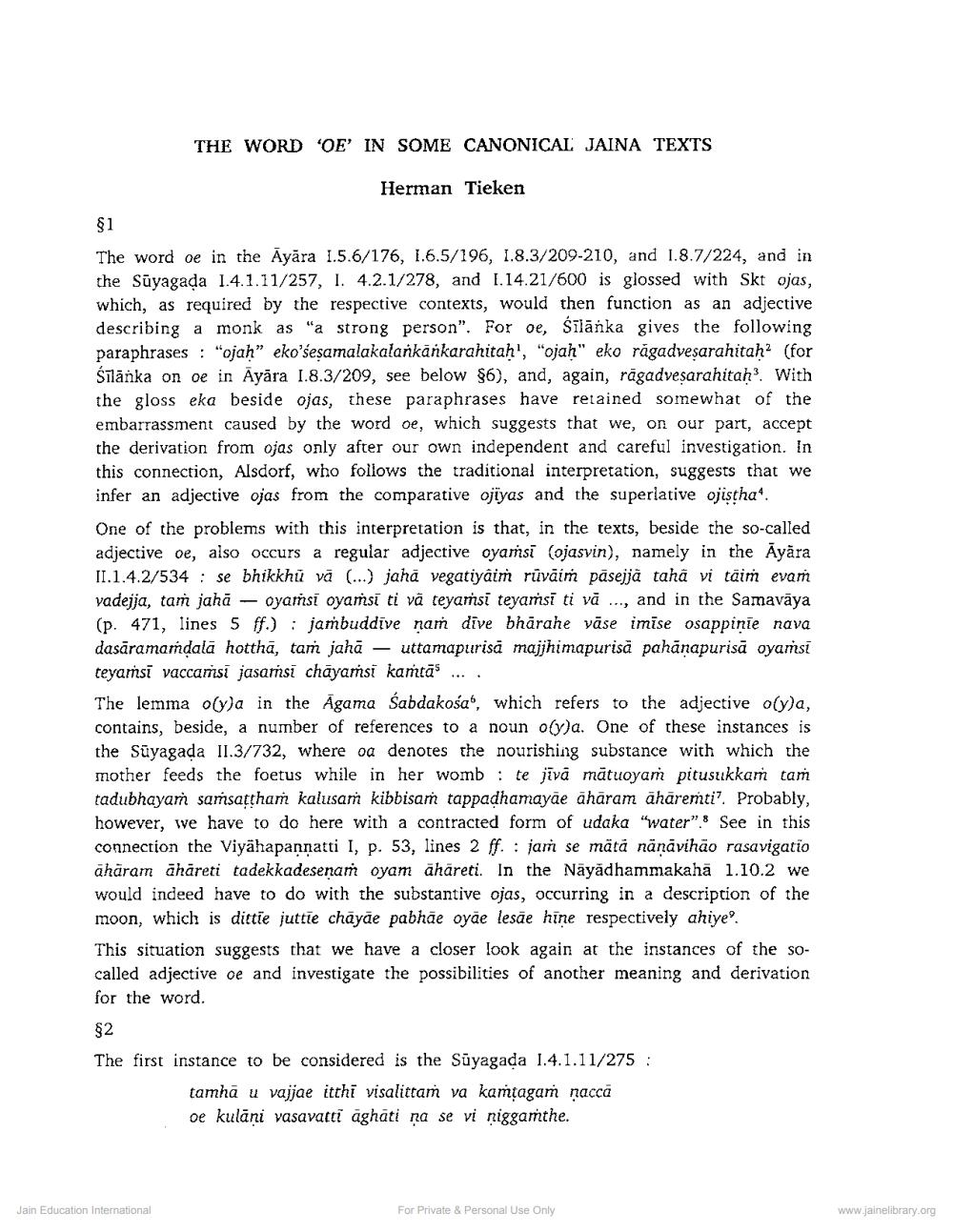Book Title: Word OE in Some Canonical Jaina Texts Author(s): Hermen Tieken Publisher: Z_Nirgrantha_1_022701.pdf and Nirgrantha_2_022702.pdf and Nirgrantha_3_022703.pdf View full book textPage 1
________________ THE WORD OE' IN SOME CANONICAL JAINA TEXTS Herman Tieken $1 The word oe in the Āyāra 1.5.6/176, 1.6.5/196, 1.8.3/209-210, and 1.8.7/224, and in the Sūyagada 1.4.1.11/257, I. 4.2.1/278, and 1.14.21/600 is glossed with Skt ojas, which, as required by the respective contexts, would then function as an adjective describing a monk as "a strong person". For oe, Silanka gives the following paraphrases : "ojah" eko'sesamalakalankankarahitah", "ojah" eko ragadveşarahitah(for Sīlānka on oe in Ayāra 1.8.3/209, see below 36), and, again, rāgadveşarahitah. With the gloss eka beside ojas, these paraphrases have retained somewhat of the embarrassment caused by the word oe, which suggests that we, on our part, accept the derivation from ojas only after our own independent and careful investigation. In this connection, Alsdorf, who follows the traditional interpretation, suggests that we infer an adjective ojas from the comparative ojiyas and the superlative ojisthat. One of the problems with this interpretation is that, in the texts, beside the so-called adjective oe, also occurs a regular adjective oyamsī (ojasvin), namely in the Ayāra II.1.4.2/534 : se bhikkhu vă (...) jahā vegatiyaim rüvaim pasejjä tahā vi taim evam vadejja, tam jahā - oyaṁsi oyamsi ti vā teyamsi teyamsi ti vā ..., and in the Samavāya (p. 471, lines 5 ff.) : jambuddive nam dīve bhārahe vase imīse osappinie nava dasāramandala hotthā, tam jahā – uttamapurisă majjhimapurisă pahanapurisă oyamsi teyamsi vaccamsi jasarsi chāyaṁsi kamtās .... The lemma olyja in the Agama śabdakośa“, which refers to the adjective olya, contains, beside, a number of references to a noun oly)a. One of these instances is the Süyagada 11.3/732, where oa denotes the nourishing substance with which the mother feeds the foetus while in her womb : te jīvā mātuoyam pitusukkam tam tadubhayam samsattham kalusam kibbisam tappadhamayāe ahāram aharemti? Probably, however, we have to do here with a contracted form of udaka "water" ! See in this connection the Viyahapannatti I, p. 53, lines 2 ff. : jam se mätä nānāvihão rasavigatio ahāram āhareti tadekkadesenam oyam ahāreti. In the Nāyādhammakahā 1.10.2 we would indeed have to do with the substantive ojas, occurring in a description of the moon, which is dittie juttie chāyāe pabhāe oye lesāe hine respectively ahiye This situation suggests that we have a closer look again at the instances of the socalled adjective oe and investigate the possibilities of another meaning and derivation for the word. $2 The first instance to be considered is the Süyagada 1.4.1.11/275: tamhā u vajjae itthi visalittam va kamțagam raccă oe kulāni vasavatti aghati na se vi niggamthe. Jain Education International For Private & Personal Use Only www.jainelibrary.orgPage Navigation
1 2 3 4 5 6 7 8 9 10 11 12 ... 16
